Stories from Country 2022
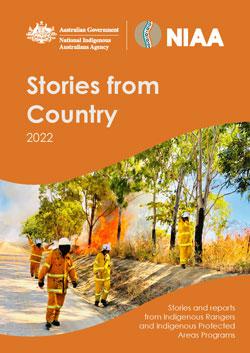
Stories from Country 2022 is a celebration of the work of Indigenous ranger teams in caring for Country and culture across Australia through the Indigenous Rangers and Indigenous Protected Areas Programs.
Please note that this report may contain images and names of Aboriginal or Torres Strait Islander people who have passed away.
About this publication
Stories from Country 2022
Stories and reports from Indigenous Rangers and Indigenous Protected Areas Programs
© Commonwealth of Australia 2022
ISBN 978-1-925365-04-7 (PDF & HTML)
Copyright Notice
With the exception of the Commonwealth Coat of Arms and third party material, this work is licensed under a Creative Commons Attribution-Non Commercial-NoDerivs 4.0 International licence (CC BY-NC-ND 4.0)
Third party copyright
Wherever a third party holds copyright in this material, the copyright remains with that party. Their permission may be required to use the material.
Please contact them directly.
Attribution
This publication should be attributed as follows: © Commonwealth of Australia, National Indigenous Australians Authority, Stories from Country 2022: Stories and reports from Indigenous Rangers and Indigenous Protected Areas Programs.
Foreword
We are delighted to present the latest edition of Stories from Country. This publication celebrates and acknowledges the work of those engaged in caring for Country and Culture under the Indigenous Rangers and Indigenous Protected Areas (IPA) Programs across Australia over the last five years.
Since the last publication in 2017, the Indigenous Rangers and IPA Programs have gone from strength to strength delivering ecological and cultural outcomes as well as creating meaningful and culturally appropriate employment and career pathways for First Nations people.
Today, these programs employ approximately 2,700 people, fund 128 ranger groups operating across Australia and support management of 81 dedicated IPAs comprising nearly 50 per cent Australia’s National Reserve System.
The focus of these programs is so valuable – they assist First Nations people to care for and connect with Country and maintain Traditional obligations at the heart of their culture and society while also providing communities with important opportunities for employment, economic development and environmental improvement. Through the management and stewardship of land and waters over large areas of Australia, these programs produce significant wider benefits for the protection of Australia’s natural environment and cultural heritage and help Australia to meet international treaty obligations to conserve biodiversity.
Over coming years we will continue to work with 80 ranger provider organisations to deliver $746 million awarded in grants to existing projects under the Indigenous Rangers Program for 2021–2028. We will also be delivering the Government’s commitments to expand the program by doubling the number of rangers by the end of the decade, and increasing investment in IPAs by $10 million per year.
You will find in this report stories about caring for Country and keeping Culture strong, most from the rangers and IPA staff themselves. These are important stories for all Australians to read. They detail ranger groups building their capacity to manage Country, expanding fee-for-service contracts, utilising external partnerships to increase employment opportunities, working with youth and embracing new technologies.
We hope this report will be shared among rangers, community members, other business partners and all others involved in these valuable activities to show how far we have come together and how important these programs are for all Australians.
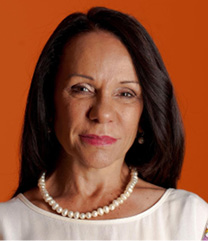

The Hon Linda Burney MP
Minister for Indigenous Australians


The Hon Tanya Plibersek MP
Minister for the Environment and Water
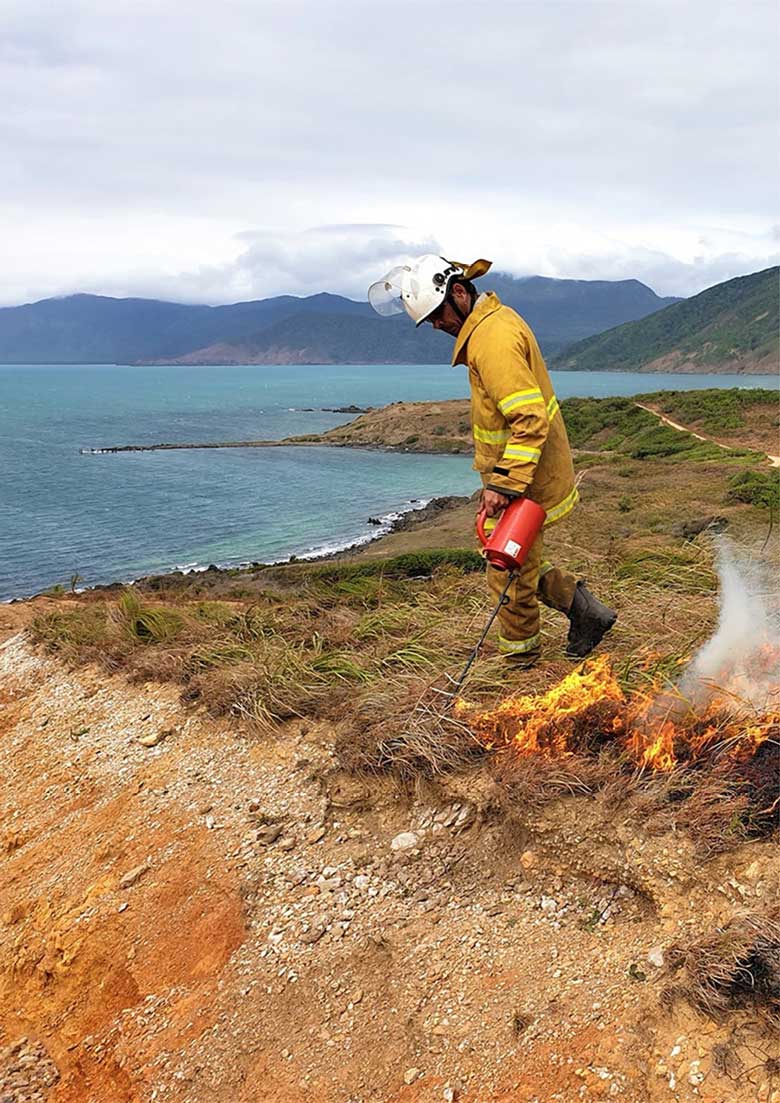
National Indigenous Australians Agency
The Australian Government’s National Indigenous Australians Agency (NIAA) is committed to improving the lives of all Aboriginal and Torres Strait Islander people.
The NIAA recognises that programs like the Indigenous Rangers and Indigenous Protected Areas (IPA) Programs are a meaningful way of formally recognising Aboriginal and Torres Strait Islander peoples’ traditional knowledge and management of Country. As of 1 July 2022, the Australian Government funds over 200 Indigenous Ranger and IPA projects, many of which also receive additional support from some state and territory governments and conservation organisations. Over 2,700 full-time, part-time and casual jobs have been created with the support of the Australian Government, with women representing over a third of this employment.
Indigenous Protected Areas – protecting Country
First Nations people use the term Country to describe the lands, waters and seas to which they are connected. An IPA is an area of Country dedicated for conservation of natural and cultural values by its Aboriginal and/or Torres Strait Islander Traditional Owners and managed to protect its biodiversity and natural and cultural resources.
IPAs make up nearly 50 per cent of Australia’s National Reserve System, which also includes state and Commonwealth national parks and other reserves. The National Reserve System is Australia’s network of protected areas, conserving examples of our unique landscapes, plants and animals for future generations.
IPAs cover around 85 million terrestrial hectares (over 3 times the size of Victoria). They may include bioregions that are under-represented in national parks and also protect many of Australia’s threatened species. They also contribute to the management of environmental threats such as climate change, wildfires and introduced plants and animals.
In 1998, the small community of Nepabunna in the Flinders Ranges were the first Indigenous Australians to dedicate their Country as an IPA. With the recent dedications of Anangu Tjutaku in 2021 and Crocodile Islands Maringa and Olkola in 2022, as at 30 June 2022 there are now 81 IPAs (of which 10 include sea country) across Australia with a further 19 projects in the consultation stage.
IPAs are administered by Indigenous organisations and managed by Aboriginal and Torres Strait Islander people under the guidance of a management plan. The plan is developed in consultation with the community and in accordance with the International Union for Nature protected area management categories.

Indigenous Rangers – managing land and sea
In 2007, the Commonwealth began funding Indigenous ranger groups to provide essential land and sea management services. The program has created around 2,000 full-time, part-time and casual jobs around the country, providing meaningful employment, training and career pathways for Aboriginal and Torres Strait Islander people.
The Indigenous Ranger Program supports Aboriginal and Torres Strait Islander people to combine traditional knowledge with conservation training to protect and manage their Country and Culture. Ranger groups manage approximately 70 per cent of IPAs and also work on Indigenous and privately owned lands, council managed lands, and state and territory parks and reserves.
Activities include protecting native plants and animals, cultural burning, controlling feral animals and invasive weeds, and maintaining tourism and cultural sites. Indigenous ranger groups also develop partnerships with research, education, conservation and other organisations to share skills and knowledge, engage with schools, and generate additional income and jobs.
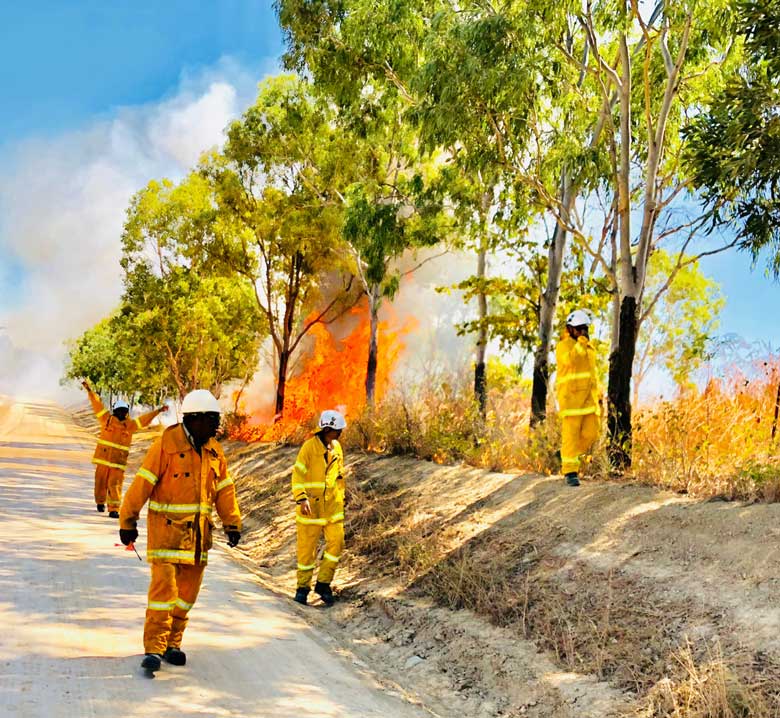
A number of new Indigenous ranger groups have been funded by the NIAA since the last Stories from Country publication in 2017, including: Mid-West Aboriginal Rangers, Spinifex Rangers, and Ngadju Rangers in 2017, the Mutitjulu Tjakura Rangers, Oak Valley Rangers, Kiwirrkurra Rangers, Gamay Rangers, and Jahnala Yenbalehla Rangers in 2018, Arabana Rangers in 2019, the Tjaltjraak, Wreck Bay, Yawuru and Barkandji Rangers in 2020, and the Wellesley Island Rangers in 2021. There are now a total of 128 funded groups providing frontline environmental services while also delivering social and economic benefits for their communities.
.jpg)
Indigenous Rangers and Indigenous Protected Areas Programs
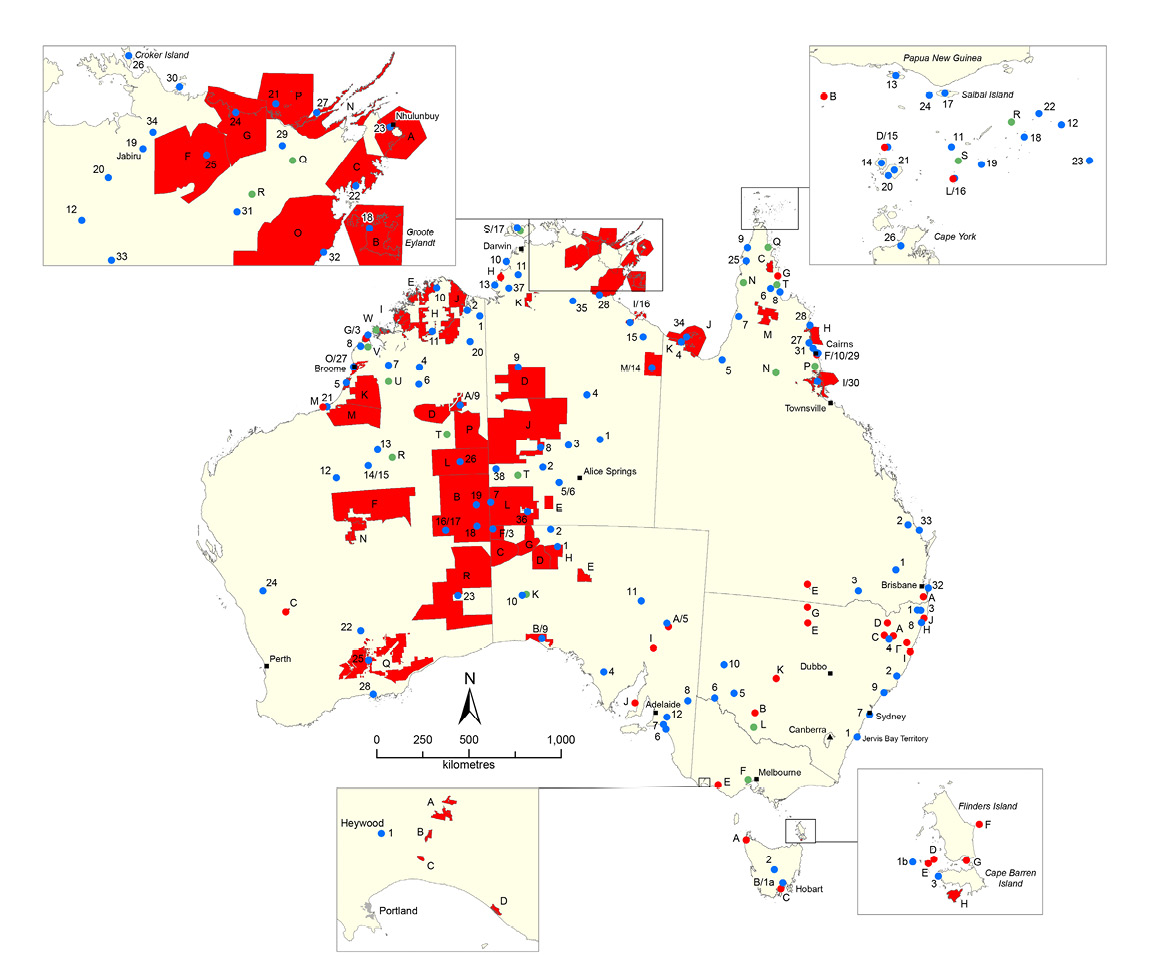
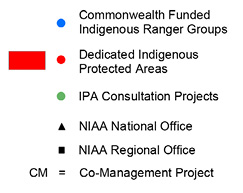
IPAs
Queensland
- Guanaba
- Warul Kawa
- Kaanju Ngaachi Wenlock and Pascoe Rivers
- Pulu
- Jamba Dhandan Duringala
- Mandingalbay Yidinji
- Angkum
- Eastern Kuku Yalanji
- Girringun
- Thuwathu/Bujimulla
- Nijinda Durlga
- Warraberalgal and Porumalgal
- Olkola
New South Wales
- Wattleridge
- Toogimbie
- Tarriwa Kurrukun
- Boorabee and the Willows
- Brewarrina Ngemba Billabong
- Dorodong
- Weilmoringle
- Minyumai
- Gumma
- Ngunya Jargoon
- Mawonga
Victoria
- Lake Condah
- Kurtonitj
- Tyrendarra
- Deen Maar
- Framlingham Forest
Tasmania
- Preminghana
- Risdon Cove
- Putalina
- Mount Chappell Island
- Badger Island
- Babel Island
- Great Dog Island
- lungatalanana
South Australia
- Nantawarrina
- Yalata
- Watarru
- Walalkara
- Mount Willoughby
- Kalka – Pipalyatjara
- Apara – Makiri – Punti
- Antara – Sandy Bore
- Yappala
- Wardang Island
Western Australia
- Paruku
- Ngaanyatjarra
- Ninghan
- Warlu Jilajaa Jumu
- Uunguu
- Birriliburu
- Bardi Jawi
- Wilinggin
- Dambimangari
- Balanggarra
- Karajarri
- Kiwirrkurra
- Nyangumarta Warrarn
- Matuwa and Kurrara-Kurrara
- Yawuru
- Ngururrpa
- Ngadju
- Anangu Tjutaku
Northern Territory
- Dhimurru
- Anindilyakwa
- Laynhapuy
- Northern Tanami
- Angas Downs
- Warddeken
- Djelk
- Marri-Jabin (Thamurrurr)
- Yanyuwa (Barni – Wardimantha Awara)
- Southern Tanami
- Wardaman
- Katiti Petermann
- Ganalanga-Mindibirrina
- Marthakal
- South-East Arnhem Land
- Crocodile Islands Maringa
Consultation projects
At 30 June 2022, there were 19 IPA consultation projects working towards IPA dedication.
Indigenous Rangers
Queensland
- Bunya Mountains Murri Rangers
- Gidarjil Working on Country
- Queensland Murray Darling Rangers
- Gangalidda Garawa and Gkuthaarn Rangers Rangers
- Kurtijar, Gkuthaarn, and Kukatj Rangers
- Kalan Rangers
- Kowanyama Rangers
- Lama Lama Rangers
- Mapoon Land and Sea Rangers
- Mandingalbay Yidinji Rangers
- lamalgal Rangers
- Erubam Rangers
- Malu Kiai Rangers
- Mura Badhugal Rangers
- Mabuygiw Rangers
- Warraberalgal Rangers
- Mura Buway Rangers
- Masigalgal Rangers
- Porumalgal Rangers
- Mua Lagalgau Rangers
- Mua Lagalgau Rangers
- Ugaram Rangers
- Meriam Gesep A Gur Keparem Rangers
- Simakal Rangers
- Nanum Wungthim Land and Sea Rangers
- Northern Peninsula Area Apudthama Rangers
- Eastern Kuku Yalanji Indigenous Land and Sea Rangers
- Yuku-Baja-Muliku Rangers
- Gunggandji Rangers
- Girringun Rangers
- Yirrganydji Indigenous Land and Sea Rangers
- Quandamooka Rangers
- Gidarjil Sea Ranger Unit
- Wellesley Islands Rangers
New South Wales
- Githabul Aboriginal Rangers
- Mid North Coast Aboriginal Rangers
- Ngulingah Aboriginal Rangers
- Aboriginal Ranger Program – Wattleridge & Tarriwa Kurrukun IPAs
- Willandra Lakes World Heritage Area Rangers
- Barkindji Maraura Rangers
- Botany Bay Rangers
- Jahnala Yenbalehla Rangers
- Worimi Indigenous Rangers
- Barkandji River Rangers
ACT/Jervis Bay Territory
- Bhewerre Rangers
Victoria
- Budj Bim Rangers
Tasmania
- milaythina pakana Rangers
- Tasmanian Aboriginal Trainee Rangers
- truwana Rangers
South Australia
- APY Land Management Trainee Rangers
- Anangu Pitjantjatjaraku Rangers
- Anangu Pitjantjatjaraku Rangers
- Gawler Ranges Rangers
- Nantawarrina Rangers
- Ngarrindjeri Rangers
- Raukkan Rangers
- Riverland Rangers
- Yalata Rangers
- Oak Valley Rangers
- Arabana Rangers
- Coorong and Murray Lower Lakes Area Rangers
Western Australia
- Miriuwung Gajerrong Rangers for Reserve 31165
- Balanggarra Rangers
- Bardi Jawi Rangers
- Gooniyandi Rangers
- Karajarri Rangers
- Yanunijarra Ngurrara Rangers
- Nyikina Mangala Rangers
- Nyul Nyul Rangers
- Paruku Rangers
- Uunguu Rangers
- Wunggurr Rangers
- Jigalong Rangers
- Punmu Rangers
- Parngurr Men Rangers
- Parngurr Women Rangers
- Warburton Women Rangers
- Warburton Men Rangers
- Blackstone Rangers
- Warakurna Rangers
- Kija Rangers
- Nyangumarta Rangers
- Goldfields Land Management Rangers
- Spinifex Rangers
- Mid West Aboriginal Rangers
- Ngadju Rangers
- Kiwirrkurra Rangers
- Yawuru Rangers
- Tjaltjraak Rangers
Northern Territory
- Alyawarra Rangers
- Anangu Luritjiku Rangers
- Anmatyerr Rangers
- Muru-warinyi Ankkul Rangers
- Tjuwanpa Rangers
- Tjuwanpa Women Rangers
- Kaltukatjara Rangers
- Warlpiri Rangers
- North Tanami Rangers
- Bulgul Land and Sea Rangers
- Malak Malak Rangers
- Wagiman Rangers
- Thamarrurr Rangers
- Garawa / Waanyi Garawa Rangers
- Garawa Rangers
- Li-Anthawirriyarra Sea Rangers
- Tiwi Islands Land and Marine Management
- Anindilyakwa Rangers
- Warnbi Rangers
- Werenbun Rangers
- Crocodile Islands Rangers
- Yirralka Rangers
- Dhimurru Rangers
- Bawinanga Rangers
- Warddeken Rangers
- Garngi Land and Sea Rangers
- Gumurr Marthakal Rangers
- Yugul Mangi Land and Sea Rangers
- Arafura Swamp Ranger Groups
- Wanga-Djakamirr Rangers
- Gurruwiling Rangers
- South East Arafura Catchment Rangers
- Mardbalk Land and Sea Rangers
- Mimal Rangers
- Numbulwar Numburindi Amalagayag Inyung Land and Sea Rangers
- Jawoyn Rangers
- Njanjma Rangers
- Mangarrayi Rangers
- Mutijulu Tjakura Rangers
- Asyrikarrak Kirim Rangers
- Walungurra Rangers
Keeping Culture Strong
Aboriginal and Torres Strait Islander cultures are a critical part of our national identity. Indigenous Ranger and IPA Programs encourage cultural respect and have a strong cultural focus. Project activities provide an opportunity for rangers to engage with community members to maintain or renew their cultural connections to Country and to care for cultural heritage.
Transferring Cultural knowledge
Men’s Culture Camp
The Kiwirrkurra Rangers held a successful three-day Men’s Culture Camp where Elders taught the younger men about important cultural sites, stories and songs.
Traditional spear making was another focus; from selecting and cutting stems, to straightening and sharpening the spears. When finished, the men tested them with a woomera (spear thrower) to see how far and accurately they could throw them.
The camp was a joint activity with Ten Deserts Indigenous Cultural Ecological Knowledge project. WA, 2019–20.
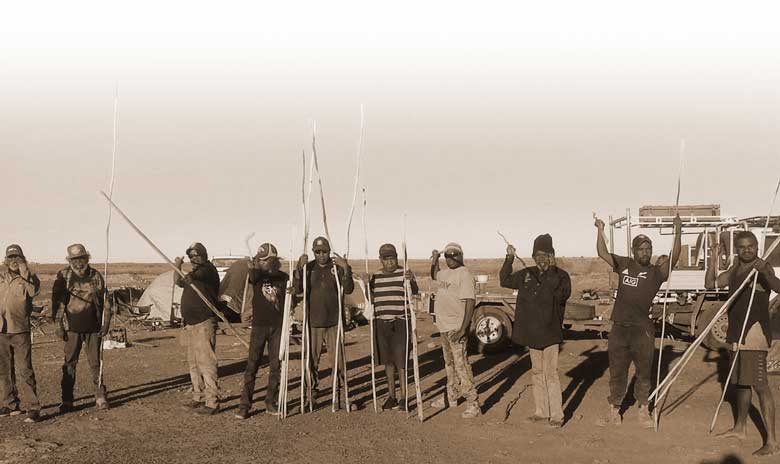
Recording a digital story book
Traditional Owners of the Northern Tanami IPA produced a Digital Storybook – a Warlpiri language online version of the IPA’s management plan. Most filming trips were conducted on Country, where Yapa (Warlpiri people) felt more comfortable to speak about Country and Culture.
The completed storybook was launched in Lajamanu in November 2019. The North Tanami Rangers distributed the storybook videos on USB sticks to members of the Lajamanu community. NT, 2018–19.
Reviving traditional gardening
Saibai people in the Torres Strait have a long tradition of subsistence gardening. However, with the arrival of a community store, traditional gardening for food has become less common. In 2015, the Saibai Mekem Garden was created as a way to revive and promote traditional gardening methods in the community.
The Mura Buway Rangers regularly carry out work with My Pathway (job seeker) participants to plant, harvest and perform general maintenance. The recent harvest which included watermelon, yams, bananas and cassava was shared with the Saibai community. Qld, 2019–20.
Cultural Knowledge Day
In April 2021, 41 people (including 12 children) took part in a Cultural Knowledge Transfer Day as part of the Yappala IPA project. Held annually, the day is about imparting knowledge, wisdom and skills from Elders to young people. Activities included cooking kangaroo tails, sewing a kangaroo and possum skin rug, grinding ochre, collecting bush medicine and learning about songlines and traditional stories. SA, 2021.
Cultural burning – a link to Country
The Budj Bim Rangers, with Elders and stakeholders, conducted traditional burns on the IPA in May 2020. This began with a ‘Welcome to Country’ and cleansing ceremony which involved passing through the smoke of the cherry balart. They then created fire in the traditional way to use for their cultural burns.
Cultural traditional burning has and always will, continue to be intergenerational, a vital link to Country that must endure…
The rangers note that cultural burns are slow, reducing the chance of plants and animals being harmed, and encouraging seed germination. Vic, 2019–20.
Burning message from the past
Recently discovered aerial photos from 1947 show strange crosshatch patterns in desert spinifex country. These are small, patchy fire scars left by Karajarri people living traditionally, and they are now being used to inform modern fire management.
The Karajarri Rangers and ecologists are also assessing if current aerial and ground burning is improving the health of Country on the IPA by using bush tucker, fauna and vegetation as indicators. WA, 2020–21.
Mala trip
In July 2018, around 20 Warlpiri and Luritja people associated with the Southern Tanami IPA set off on a trip to see some reintroduced mala wallabies, which were once common on their Country. They also visited Mawurrungu, the place where the mala ancestors came from, and other cultural sites. The four-day trip allowed some of the mala songlines to be followed and traditional songs, dances and stories to be performed on Country.
The mala along with many other native animals, have disappeared from Central Australia due to predation from cats and foxes. Before they were declared extinct in the wild, some were removed for their protection. In 2017–18, about 30 mala were returned to their Country. They were released into a large predator-proof area at Newhaven, built by the Australian Wildlife Conservancy. NT, 2018.
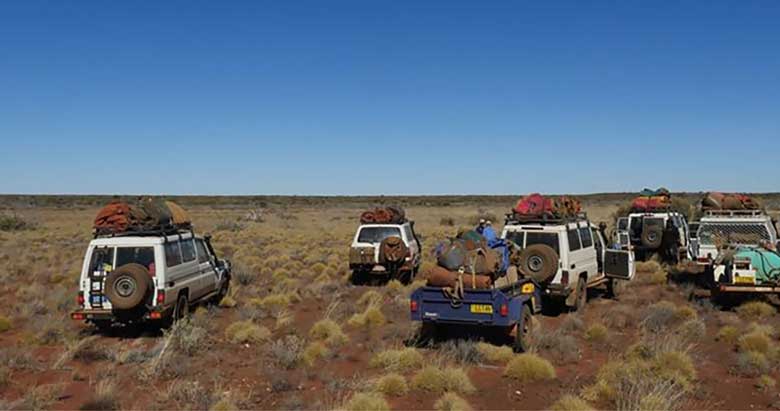
Recording water trees
In the past, the Ngadju people created water trees by fashioning depressions in the forks of trees to catch water. After the 2019–20 bushfires, the Ngadju Rangers discovered that groups of these culturally important trees had been burnt.
To help save water trees from future back burns and wildfires, the rangers added the location of over 70 trees to their database during the reporting period. They also cleared around the trees to help protect them from fire and removed accumulated debris from their hollows. WA, 2019–20.
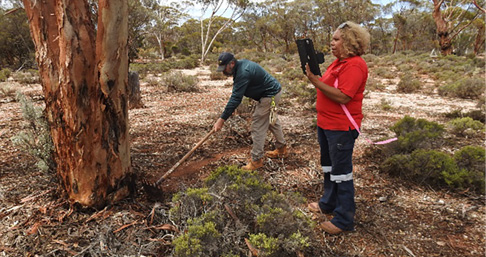
Protecting cultural sites
In parts of Northern Australia, feral water buffalo numbers are increasing.
Buffalo create management challenges by damaging floodplain ecosystems, degrading important cultural sites and contributing to the loss of bush tucker.
Aerial culling has been used to remove around 2,500 feral animals from the Djelk IPA. The Bawinanga Rangers also installed exclusion fencing at Dilly Bag Dreaming to protect this important cultural site.
NT, 2020–21.
Seed conservation artwork
During 2022, the Northern Agricultural Catchments Council Incorporated (NACC) NRM, and delivery partner Kwelena Mambakort Aboriginal Corporation, supported an Aboriginal Women’s Conservation Team to carry out seed collection, seed cleaning, and storage activities on Yued boodja (Country), with training in partnership with Elders and Registered Training Organisations.
The team of Mid West Aboriginal Rangers included Deborah Nannup, a respected Yued Elder and well known artist. To depict the activities, Deborah completed an artwork as a journal of her seed collection experience showing the Noongar six seasons walk trail. NACC NRM was proud to receive the artwork. WA, 2022.
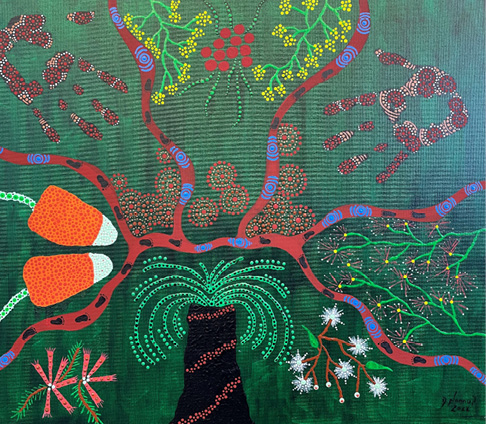
Caring for Cultural heritage
World Heritage listing
In July 2019, the Budj Bim aquaculture system was added to the UNESCO World Heritage List. Australia now has 20 sites on the list – including Kakadu National Park and the Sydney Opera House – but Budj Bim is the first site to be added exclusively for its Indigenous cultural significance.
Budj Bim is home to one of the world’s oldest and most extensive aquaculture systems. Over 6,600 years, the Gunditjmara people used volcanic stone to develop a network of channels, dams and weirs to trap kooyang (eels) and other fish for food. They also built many circular stone-walled houses with the remains spread throughout the landscape.
Mentored by Gunditjmara Elders, the Budj Bim Rangers continue to maintain and manage the aquaculture systems by controlling weeds and feral animals, revegetating areas, and guiding visitors. Vic, 2019.
.jpg)
Recording and dating rock art
The Warddeken IPA borders Kakadu National Park and protects over a million hectares of Arnhem Land’s stone and gorge country. It contains over 30,000 kunwarddebim (rock art) sites, protecting a significant part of Australia’s cultural heritage.
Warddeken Rangers expressed an interest in finding out the age of older rock paintings in recently used occupation shelters. In February 2019, rangers, in collaboration with researchers from the Centre of Excellence for Australian Biodiversity and Heritage, sampled ancient mud wasp nests that had been built on top of paintings. This allowed researchers to work out the minimum age of the kunwarddebim, as paintings underneath the nests are older.
This was the first time any kunwarddebim within the Warddeken IPA had been dated, and results showed that one painting was at least 20,000 years old – possibly even older! NT, 2019–20.
Keeping Country Strong
Indigenous Country encompasses both natural and cultural landscapes. Indigenous Rangers use traditional knowledge and western science to manage Country. Work is often undertaken collaboratively with conservation agencies and research organisations. Activities include cultural burning and fire management, protecting threatened species and bush tucker, controlling pest animals and weeds, and caring for sea and freshwater.
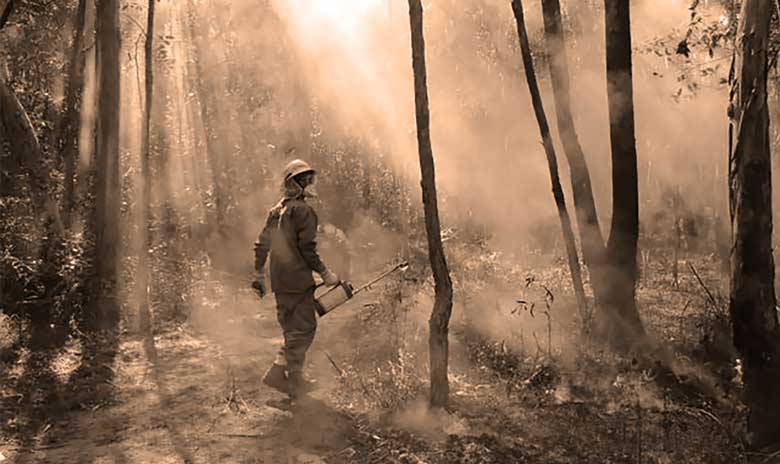
Cultural burning and managing fire
Looking after Country with fire
The Southern Tanami IPA covers more than 10 million hectares and is the largest terrestrial conservation reserve in Australia.
The Warlpiri Rangers and colleagues from Kintore and Kiwirrkurra teamed up with 24 Elders to spend a week patch burning the vast sand dune and spinifex country in the IPA’s Lake Mackay area. A helicopter allowed people to access Country and create traditional patchy burns. NT 2019–20.
The desert has had people walking around and burning in it for a very long time, so the plants and animals have become adapted to fire...Because people are not living on Country anymore we need to go out and look after Country with fire.
Renewing cultural burning
The truwana Rangers introduced traditional burning on truwana (Cape Barren Island) after 2 damaging fires in 2006 and 2016. The rangers attended 3 National Indigenous Fire Workshops which helped progress their cultural fire management.
They also received training from the Tasmanian Fire Service, became volunteer firefighters and successfully managed their first wildfire in 2018. Tas, 2017–18.
Protecting Country from fire
In late 2018, a bushfire sparked by lightning burnt over 3,200 hectares on Minjerribah (North Stradbroke Island). The Redland City Bulletin reported that more than 250 firefighters, police and support crews from interstate helped bring the bushfire under control.
The Quandamooka Rangers maintained a 24 hour presence during the fire and took lead in protecting a significant cultural site on the southern end of Minjerribah. The rangers were instrumental in guiding water bombing operations from aircraft to protect cultural sites and landscapes.
The Quandamooka Rangers’ efforts were recognised by the Queensland Premier and the Environmental Minister as an outstanding example of Traditional Owners leading the protection of Culture and Country during a disaster event. Qld, 2018.
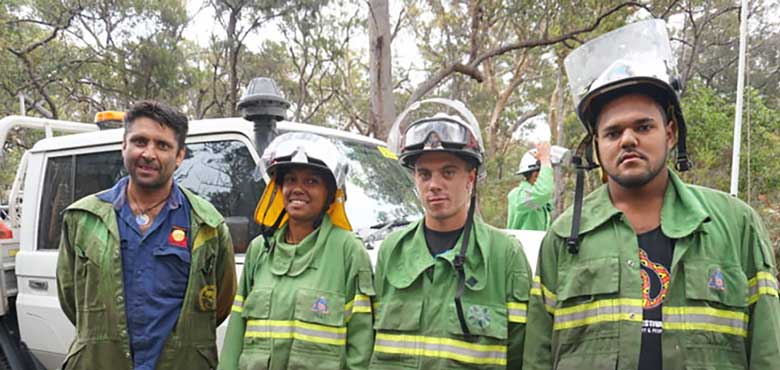
Helping koalas after bushfire
The Black Summer fires burnt around 75 per cent of the Ngunya Jargoon IPA. Rangers worked with conservation partners to search for surviving koalas in the aftermath. Rescued koalas were housed and cared for off-site, and drinking stations were installed on the IPA. In December 2019, some of the first rehabilitated koalas were released on the IPA with local school children watching on. NSW, 2019–20.
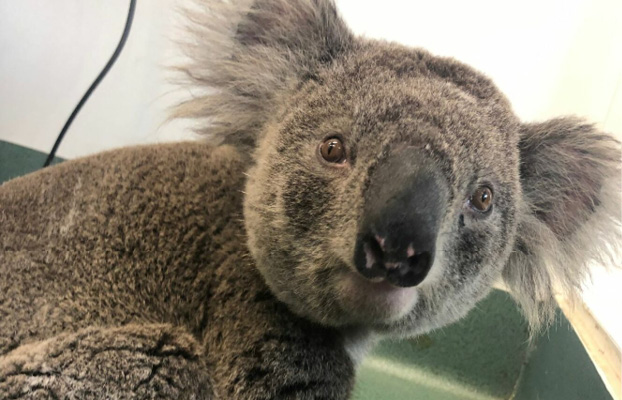
Bushfire recovery efforts
In the winter of 2019, the Jahnala Yenbalehla Rangers carried out cultural burning on the Minyumai IPA. Despite this, the sheer intensity of the summer bushfires in the area burnt over 90 per cent of the IPA and killed or damaged many of the large habitat trees. As part of the bushfire recovery, rangers worked with conservation partners to install nesting boxes to provide artificial hollows for birds and gliders. Motion cameras and sound recorders were also installed to monitor wildlife after the bushfires. NSW, 2019–20.

Caring for plants and animals
Protecting island seabirds
Torres Strait Island rangers and Traditional Owners from Warraber, Poruma and Iama came together to remove plastic and other marine debris from islands within the Warraberalgal Porumalgal IPA. This work helps protect seabirds using rookeries on the Central Islands. Qld, 2019.
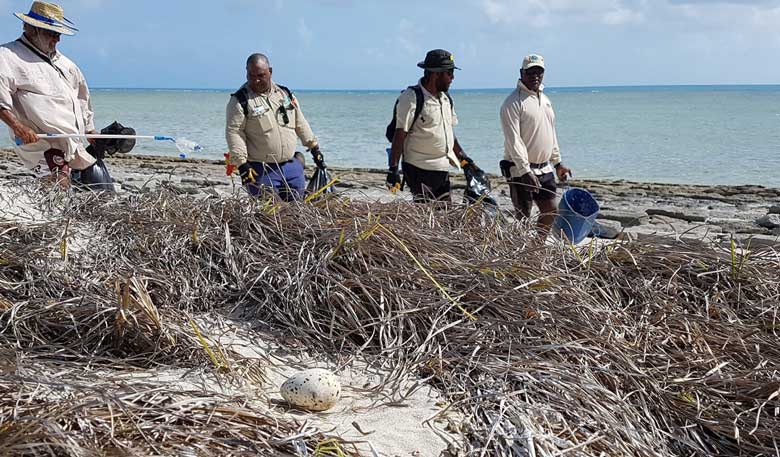
New IPA is home to malleefowl
Dedicated in 2019, Mawonga IPA’s old-growth mallee is home to large mound building Yungkay (malleefowl). Listed as vulnerable, Mawonga IPA staff and Western Local Land Services worked together to monitor yungkay mounds in the IPA. They located 15 mounds, 2 of which showed signs that they were being tended and also spotted a yungkay which caused much excitement.
The Mawonga IPA staff continue to control foxes which prey on yungkay, and wild goats that alter habitats and compete for food. NSW, 2019–20.
Managing Traditional hunting
The Gunggandji Aboriginal Corporation developed a hunting policy in consultation with Elders in 2019 to help protect traditionally important species like dugongs and turtles.
The Gunggandji Land and Sea Rangers enforced the policy by providing statements to the Great Barrier Reef Marine Park Authority so the prosecution of individuals taking excessive numbers of marine animals could occur. Qld, 2019–20.
Surveying migratory shorebirds
The Gangalidda and Garawa Rangers and Normanton Rangers undertook migratory shorebird surveys in early 2020.
Surveying the mouths of the Albert and Flinders Rivers, each shorebird species was identified, counted and recorded, along with any tagged birds. Photos and data were then sent to an ornithologist for feedback and verification. The rangers were successful in identifying and counting the birds with accuracy. Qld, 2019–20.
Monitoring endangered species
The Matuwa Kurrara Kurrara IPA, dedicated in 2015, includes a 1,100 hectare predator-proof compound erected by the Western Australian Government. For the last few years, Martu Rangers have been working with the Department of Biodiversity, Conservation and Attractions (DBCA) researchers to monitor burrowing bettongs, golden bandicoots and mala.
In mid-2019, Martu Rangers and DBCA researchers monitored feral predators outside the compound using motion sensor cameras. They also monitored populations of golden bandicoots released outside the compound in 2015 by conducting 30 two-hectare plot surveys.
Based on results, DBCA researchers suggested that feral cat control before and after the release needed to cover a larger area and continue for longer, and that wild dogs also needed to be controlled. WA, 2019.
Unearthing a Northern Marsupial mole
While seldom sighted, when the weather cools down, Kiwirrkurra Rangers sometimes see mole tracks on the sandhills. None of the young rangers had ever seen kakarratulpa (northern marsupial mole), so they decided to dig one up. They found one just below the surface in an ants’ nest. Everyone was excited to see a live kakarratulpa. It’s a strange animal, no eyes, comically large claws and a luxurious golden coat. After the rangers had a good look, they released the kakarratulpa and watched it disappear back into the sand.
Remote Indigenous Ranger groups are discovering that this mole is more common than previously thought. WA, 2019.
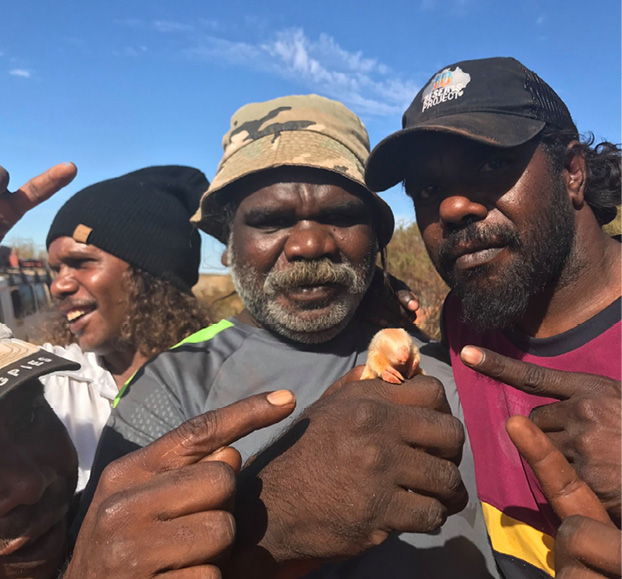
Surveying islands for wildlife
In mid-2018, Dambimangari Rangers visited the Wooddoolgoo (Augustus) island chain, with ecologists from partner organisations, to carry out a large-scale fauna survey.
Over 10 days, the team travelled around 800 kilometres on the water, utilising boats and helicopters to access areas. More than 120 motion sensing cameras were installed and retrieved. Live mammals were trapped and released and DNA samples collected.
Almost 200 species of mammals, reptiles and birds were recorded. Species of interest included the nabarlek, scaly-tailed possum, northern quoll, golden-backed tree-rat and golden bandicoot. WA, 2018.
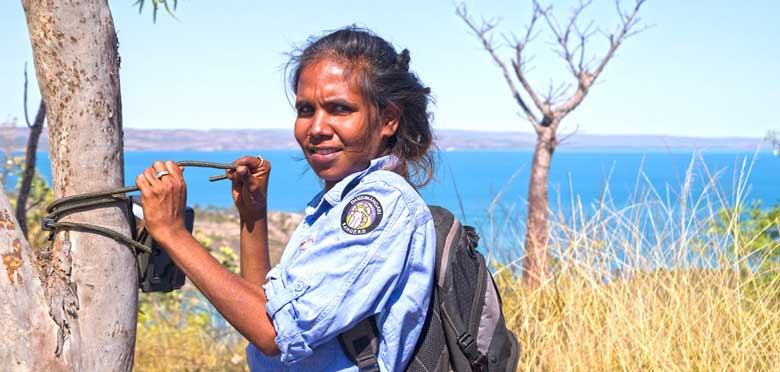
Tracking the greater bilby
Around 70 per cent of the bilby’s range is on land managed by Aboriginal people. In 2017–18, the Bilby Blitz project focused on baseline surveys, with 11 Central Land Council ranger groups using a bilingual tracks app to survey 249 two-hectare plots for tracks. They found 119 signs of bilbies in 58 plots along with 44 other species, including cats and foxes. NT, 2017–18.
Finding threatened species
Rangers set up motion cameras at 5 sites in an effort to find ching’ka (northern quoll) and Iyltipi (Cape York rock-wallaby) on the Kaanju Ngaachi Wenlock and Pascoe Rivers IPA. Although no ching’ka were caught on camera, 3 Iyltipi were. On patrol, the rangers also saw a threatened palm cockatoo and 2 endemic rainbow skinks.
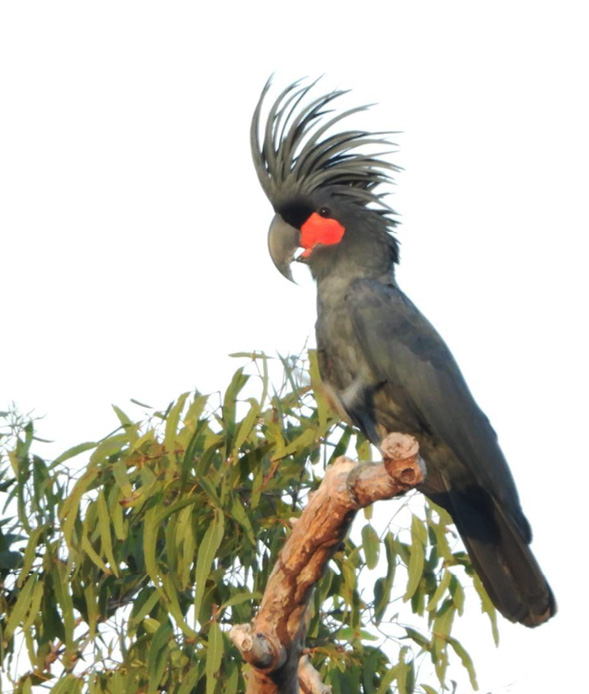
A new species, the Groote Eylandt marbled velvet gecko was found on the Anindilyakwa IPA. It is not known to occur anywhere else. Qld, 2020–21.
Introducing Australia’s newest gecko...
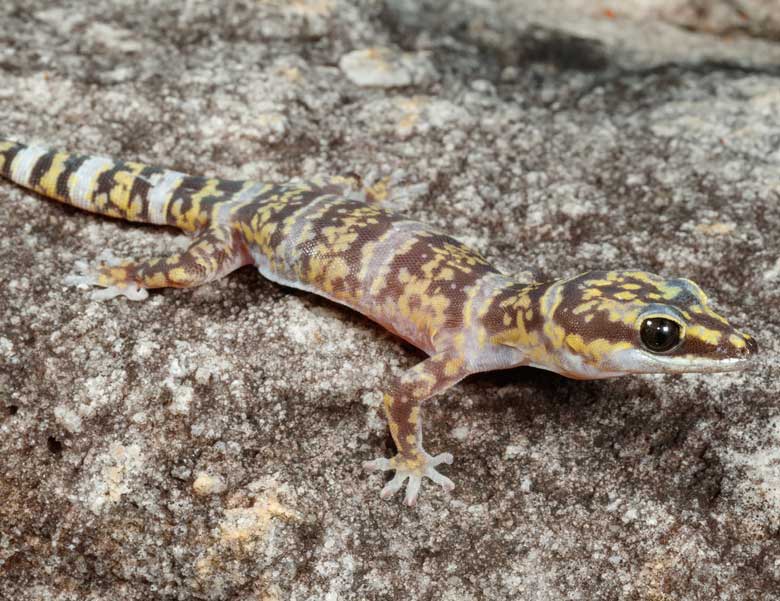
Caring for Sea Country and freshwater
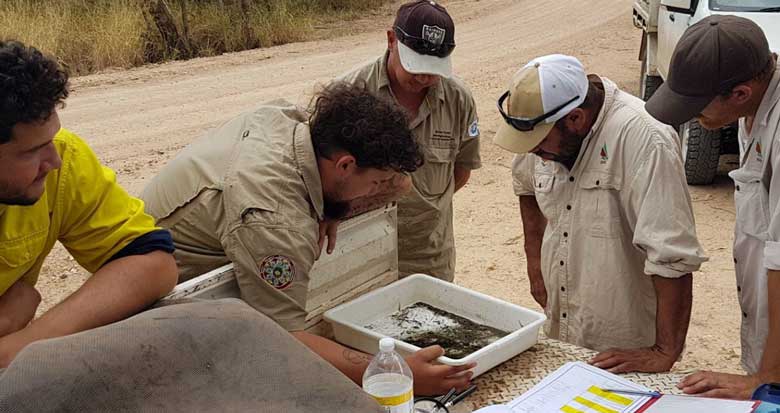
Coral reef restoration training
The Yirrganydji Land and Sea Rangers manage Country which includes part of the Great Barrier Reef. In 2019, 2 rangers travelled to Indonesia to undertake the Mars Assisted Reef Restoration System training. The system uses hexagonal steel structures with coral fragments attached to fill in gaps between dead coral rubble and live coral. The rangers aim to apply their reef restoration training in the Great Barrier Reef. Qld, 2019.
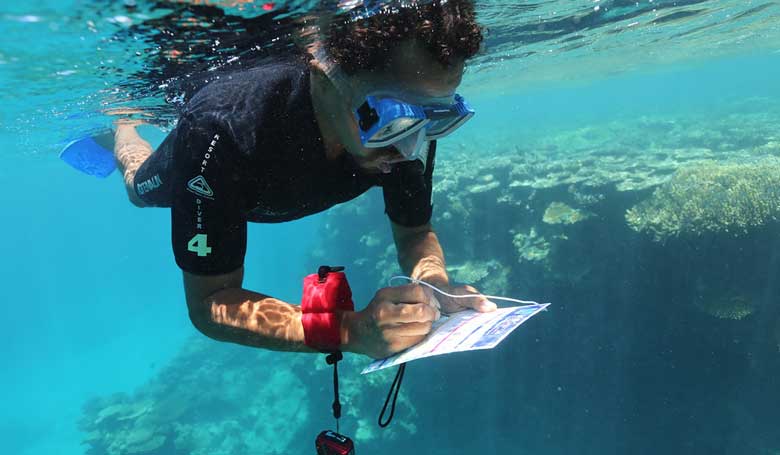
Helping to create seahorse hotels
The Gamay Rangers care for Country around Gamay (Botany Bay). The rangers helped construct and install ‘seahorse hotels’ in Sydney Harbour for the endangered white seahorse. The breeding program, run by Sea Life Sydney Aquarium, involves creating an artificial habitat to help seahorse habitat regrow. NSW, 2020–21.
Marine debris collection
In 2018, the Dhimurru Rangers and volunteers managed to clean up 26.6 kilometres of Yolgnu coast in Northern Arnhem Land. They collected and removed over 16 tonnes of plastic, fishing nets and other marine debris. The amount of rubbish removed was significantly more in volume than previous years, and is due to additional support from volunteers who were recruited through local efforts and coordinated programs with Conservation Volunteers Australia and the Sea Shepherd Rangers. NT, 2018.
Monitoring culturally important fish
In 2019, the Anindilyakwa Rangers began a project to monitor culturally important fish resources in the shallow waters around Groote Eylandt. Working in collaboration with the Australian Institute of Marine Science (AIMS), the rangers positioned baited remote underwater video stations at a number of sites to collect data. The video and temperature data collected in this long-term project is sent to AIMS to assess the annual trends in fish abundance and diversity, and provide a health status of the selected marine areas. The data is also important in understanding the impacts of climate change and contributes to AIMS’ national Sea Temperature Program. NT, 2019–21.
Toogimbie cultural flows project
The Toogimbie IPA is part of the National Cultural Flows Research Project. Since having more consistent water over a longer period of time, the wetlands have provided habitat for various culturally significant plants and animals.
Vegetation, wetland birds such as Murrugaya (spoonbills) and frogs are just some of the wildlife to benefit from environmental water releases and the construction of a rookery bank. Field staff inspecting the wetlands noted that they are now covered in a variety of rushes, sedges, tall lignum bushes and aquatic vegetation providing a diversity of habitat for wetland fauna. NSW, 2018–19.
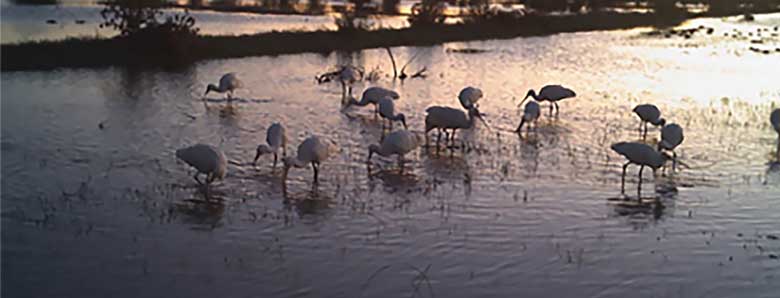
Managing pests and weeds
Controlling pigs to help sea turtles
In 2019–20, the Nanum Wungthim Rangers focused on pig control to reduce predation of sea turtle nests. During the aerial cull, 128 pigs were euthanised over 39,451 hectares.
During the nesting season, there were 354 flatback and 9 olive ridley turtle nests on Pennefather Beach. Flatback nesting success was above the minimal acceptable level at 72 per cent and clutch loss to predation was moderate, indicating that current management activities are increasing the survival rate of turtle clutches. Qld, 2019–20.
Bush regeneration work
The Githabul Rangers undertake bush regeneration projects on National Parks and State Forests within their region. On ground work involves a range of weed management techniques including spraying, hand pulling, traditional fire management, propagation and planting of native species.
The rangers reported great success with spraying and removal of lantana and privet from along the banks of the Clarence River on the Cataract site. They plan to remove regenerating tobacco bushes and wild pigs, as well as planting native trees. NSW, 2018–19.
Planning weed management
The Yugul Mangi and Numbulwar Numburindi Rangers manage weeds on the extensive South East Arnhem Land IPA with support from the Northern Territory’s Weed Management Branch. A consultant was engaged to work with the rangers to develop an IPA weed management plan. In 2018–19, the rangers used their new plan to assist with prioritising weed management activities. This included focusing on the Mimosa pigra infestation at Wanmarri and neem and rubber vine in Numbulwar. NT, 2018–19.
Tackling a mimosa outbreak
Detected on the shores of Lake Argyle in 2012, the invasive weed mimosa is suspected to have been introduced by migratory birds. The Aboriginal Rangers for Reserve 31165 have put a huge effort into the eradication of this problem weed from Western Australia. In 2017, 5,547 plants were treated or removed. The rangers will continue their efforts to keep the outbreaks under control. WA, 2020–21.
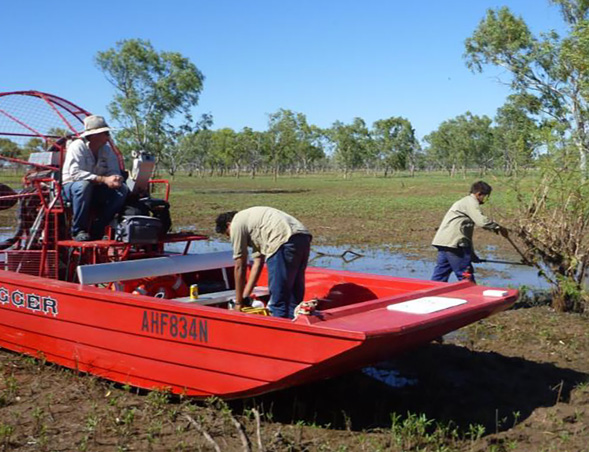
Keeping Communities Strong
Indigenous Ranger and IPA projects are developed in consultation with local communities and create meaningful jobs on Country for Aboriginal and Torres Strait Islander people. They are an important source of employment and training in regional and remote areas where jobs can be limited. Community-oriented activities include consulting Traditional Owners and Elders about important issues, organising visits to Country, engaging with local schools and children, and sharing cultural knowledge.
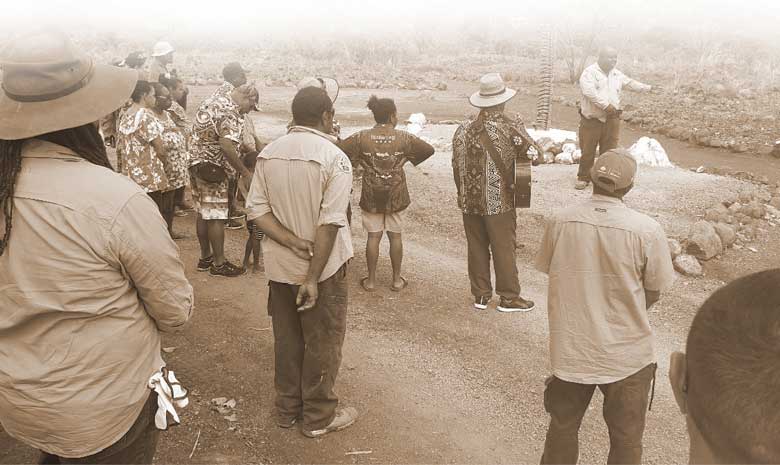
Providing Indigenous jobs and training
Breaking down barriers
In July 2019, the Ngurrara Rangers made history forming the first all-woman, all-Indigenous aerial burning chopper crew in the Kimberley! WA, 2019.
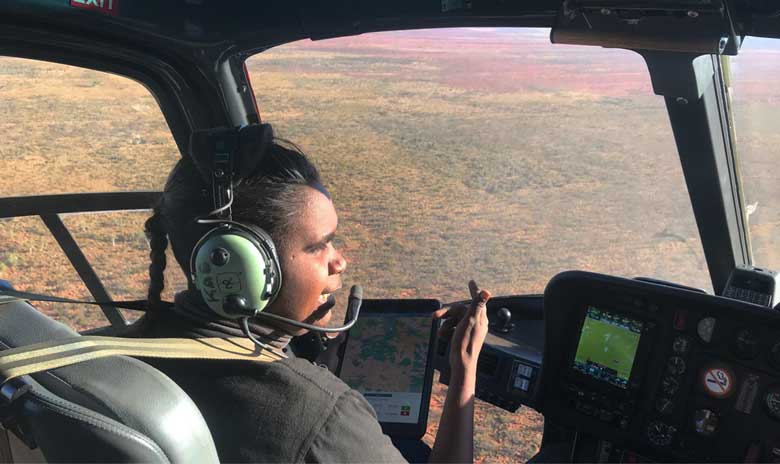
Healthy Women’s Ranger Network
In September 2019, the Mimal Rangers hosted 140 women from 27 groups across the Northern Territory. They discussed the development of a healthy women’s network and the challenges facing women working in land and sea management. In May 2021, more than double the number of women attended the Strong Women for Healthy Country Network forum at Banatjarl on Jawoyn Country. NT, 2019–21.
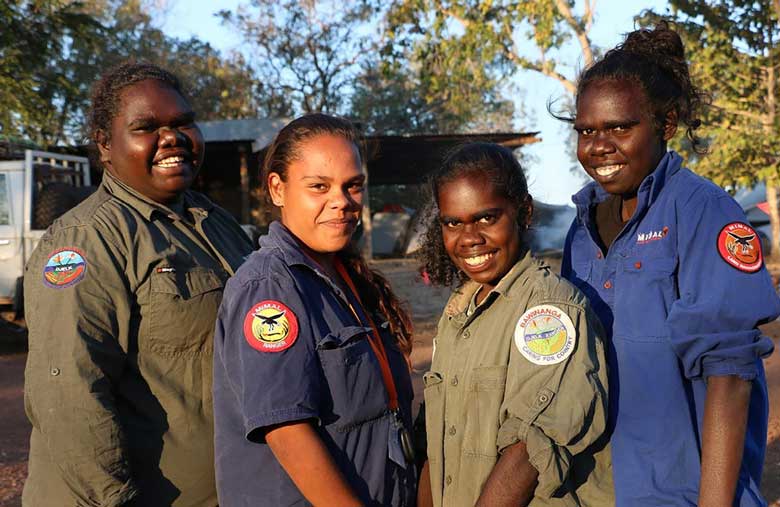
Work and training opportunities
The Barkindji Maraura Elders Environment Team’s (BMEET) ranger program is giving young Indigenous people the opportunity to work on a range of projects. In addition to learning about natural and cultural resource management, they are developing a wide range of practical skills including mechanical maintenance, welding and fencing.
In April 2019, the rangers assisted in the creation and installation of a large metal cut-out sign of an Aboriginal man with a didgeridoo for the front of the BMEET art gallery. In June, the rangers planted 800 trees on a vineyard to create habitat for threatened species such as the Regent Parrot. This was a great opportunity for the rangers to meet and work alongside people from other cultures. NSW, 2018–19.
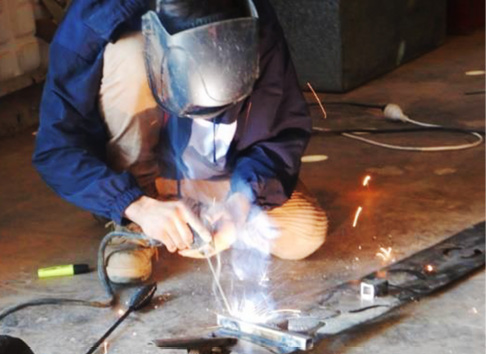
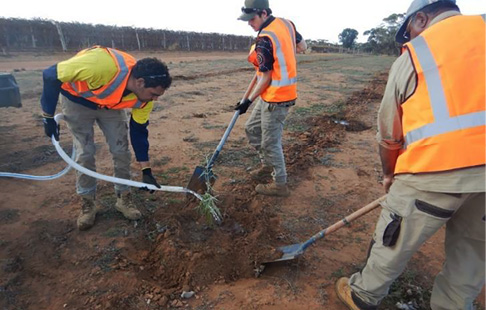
Training to be rural firefighters
The Ngadju Rangers are volunteer members of the Dundas Rural Bushfire Brigade (DRBFB) and are trained by the Department of Fire and Emergency Services. The rangers commenced fire drills in November 2020 when the fire truck was delivered and fought bushfires as the DRBFB in late December.
The Ngadju Rangers now have their own light tanker and have been doing cultural burns for the last 2 years. WA, 2019–21.
Gaining skills to change careers
Phillip Mango was employed as a ranger for 15 years, 8 years with Nanum Wungthim Land and Sea Rangers, and 7 years with Kowanyama Aboriginal Land and Natural Resources Management Office (Kowanyama Rangers) until 2020 when he was offered a role in the mining industry. Over his time as a ranger, he attained a Certificate IV in Conservation and Land Management and developed transferable workplace skills in project management, staff management and public speaking. Over his ranger career, he was promoted from ranger, to senior ranger and then to ranger coordinator for the last 3 years before deciding on a career change. Phillip continues to undertake land and natural resource management work, including land rehabilitation, throughout his role within the mining industry.
Becoming fisheries inspectors
In May 2018, Malak Malak Rangers Rob Lindsay and Aaron Green were among the first 6 Indigenous rangers appointed as Fisheries inspectors in the Northern Territory.
We’ve got limited powers but we can actually check on bag limits, size limits, fishing gear and ask for names and addresses.’
In April 2021, co-worker Theresa Lemon became the first Indigenous woman ranger to be a NT Fisheries Inspector. NT, 2018–21.
.jpg)
Engaging with communities
Cleaning up after Cyclone Trevor
In March 2019, Cyclone Trevor crossed Northern Queensland causing severe damage to the Lama Lama Ranger bases at Silver Plains and Port Stewart. The Lama Lama Rangers coordinated clean-up activities in these remote communities. Some of the challenges that were overcome included expensive road repairs, structural damage to buildings and future flood mitigation.
Despite living in damaged houses and the loss of tools and equipment, the ranger teams came together to support each other and reorganise the year’s operations.
This cyclone highlights the need to prepare Indigenous communities, emergency responses and ranger programs for recovery after natural disaster events. Qld, 2019.
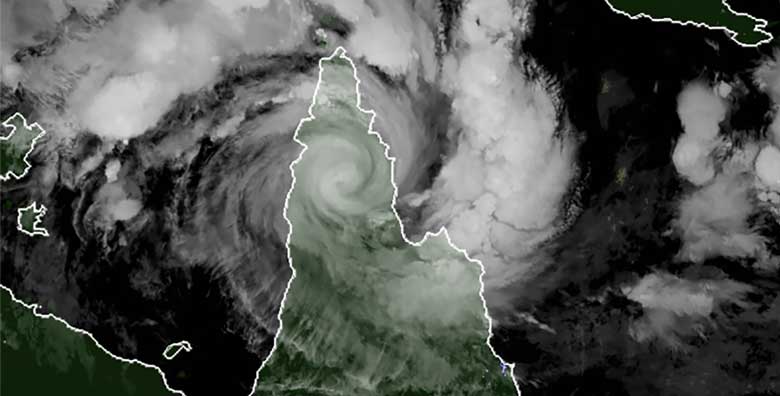
Working with prisoners
The Goldfields Land and Sea Council (GLSC) Rangers have started to engage with the Eastern Goldfields Regional Prison community.
In April 2019, 5 GLSC Rangers attended a careers open day to provide advice to 90 prisoners coming up for release. As part of this program, teams of low risk prisoners were able to work alongside rangers on Country.
Now that the foundations are in place, the GLSC Rangers plan to deliver more of this worthwhile community work. WA, 2018–19.
Community map project
The Warburton Women Rangers mapping project was a community affair. Over 54 people created the large canvas map and over 100 community members came to the barbecue launch they hosted.
The map has been used out bush for place-based cultural induction for staff. It has also been on a road trip to Uluru, where it was used by rangers to talk about the transfer of traditional ecological knowledge at an Indigenous Desert Alliance meeting. WA, 2019–20.
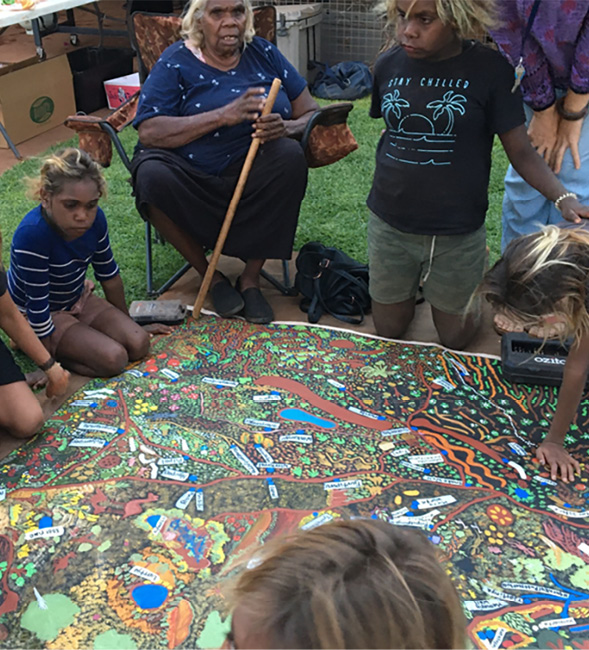
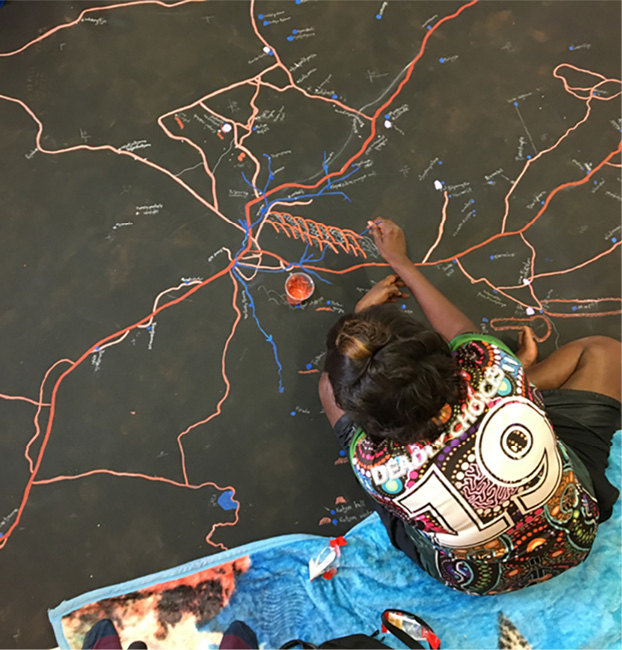
Cultural camp for senior police
Twenty-six Jigalong, Parnngurr and Punmu Rangers helped host a seven-day cultural camp for senior police with around 80 participants in total. They also assisted with workshop presentations and on Country activities such as site visits and hunting.
The camp involved a series of workshops about Martu kinship, the criminal justice system, the new Wama Wangka (talking about alcohol) initiative and discussions for a diversionary program.
Martu aren’t waiting for someone else to solve their problems. They know what needs to be done and are looking for meaningful partnerships...’
Martu Elders and leaders spoke of their strong connection to Country, their social structures and kinship, their respect for Martu law, and their experiences with the justice system. They also spoke about working towards a new story – keeping Martu out of prisons. WA, 2019.
Going to school on Country
The Nawarddeken Academy was established in 2015 and became an Independent School in 2018. Children from the Kabulwarnamyo community on the Warddeken IPA now receive ongoing education and the school has also provided local employment.
In 2019–20, the academy worked closely with Warddeken Rangers and Elders to deliver weekly Learning on Country activities. NT, 2018–20.
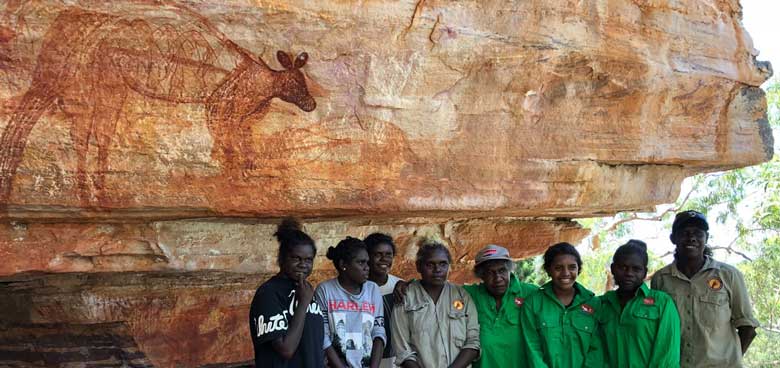
Junior and Cadet Rangers
In 2015, the Gidarjil Rangers started Junior Ranger activities with Jukanyula After School Care and, when it closed, transferred activities to North Bundaberg Primary School in 2018. The rangers identified a need in the community to cater to older students and in 2019, started the Cadet Rangers for lower secondary school students. Qld 2017–21.
New IPA governance structure
The Laynhapuy IPA in north-east Arnhem Land is vast, covering around 16,800 square kilometres with people from 13 clans living in 30 homeland communities.
Following an organisational review in 2019, the Laynhapuy Board endorsed a new governance structure, Ward Mala, that aims to facilitate more localised decision making with 3 representative bodies for the Djalkiripuyngu, Miyarrkapuyngu and Laynhapuyngu wards.
The 3 wards, aligned with existing cultural structures, aim to form a strong and powerful voice for Country and the Yirralka Rangers. The Ward Mala proposes up to 72 Wanga Watangu (Traditional Owners) and Djungayi (Caretakers) to meet bi-annually, in homelands on Country. Six representatives were nominated to be Dhawu Wikanamirr (story tellers) to attend all 6 meetings annually and share stories between the 3 wards. NT, 2020–21.
Science on Country
John T West, a part-time Kiwirrkurra Ranger and assistant teacher, helped students identify the stomach contents of feral cats in the Kiwakurra IPA. Of 12 cats caught, they identified 36 animals altogether – 8 goannas (3 species), 25 skinks (5 species), 1 legless lizard and 2 spinifex hopping mice.
Fifty-eight cats were captured during 2019–20 making it the most successful year of cat control on the IPA. Cat hunting excursions were organised by the Kiwirrkurra community several times a week during the COVID-19 restrictions. The cat hunting activities provided valuable income, got people out on Country and helped young people improve their tracking skills. WA, 2019–20.
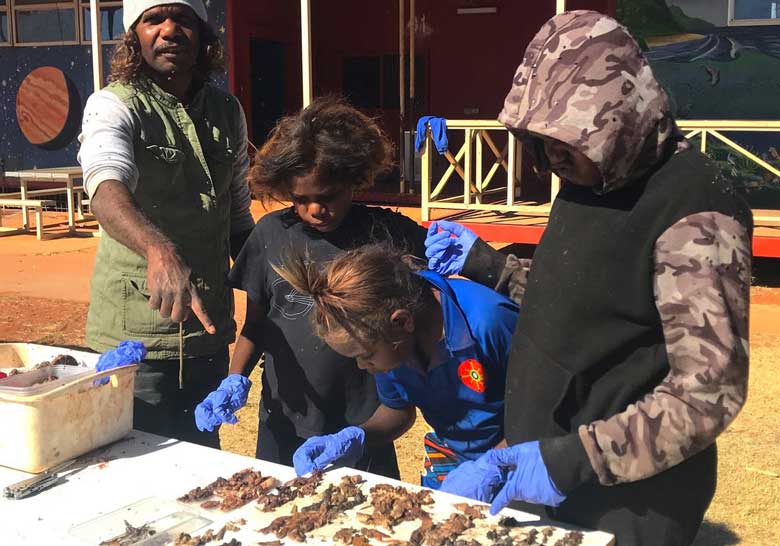
Involving the broader community
The Guanaba IPA and its local Aboriginal group have been a focal point for the broader community. People are requesting smoking ceremonies and education about the history, lore and language. They want to know more about the area’s Indigenous story and develop a connection to it. NSW, 2019–20.
Welcoming visitors
The milaythina pakana Rangers have undertaken a range of visitor projects on Tasmanian IPAs. This includes developing a heritage walk and guide map for Badger Island, hosting a community camp at Preminghana and tour guide training at putalina and piyura kitina. Tas, 2019–21.
Improving health and wellbeing
Working on Country benefits
IPA and Indigenous Ranger groups have reported many flow on benefits from their work. For rangers these include culturally meaningful employment, skills development, increased activity, better food, and improved physical and mental health. More broadly, the rangers provide positive role models and their community activities help strengthen connections to Culture and Country.
Rangers are able to see that they have a purpose through their work having real meaning and achievable outcomes.
Community mullet run
The Gamay Rangers led the Community Mullet Run, an annual cultural fishing activity at Yarra Bay, during the COVID-19 restrictions in April 2020. This was at a time where food security was an issue for some community members, particularly Elders.
The Gamay Rangers applied for a permit with the NSW Department of Planning, Industry and Environment and developed COVID-Safe plans for the event. The Rangers also cleaned, packaged and delivered fish to Elders and vulnerable members of the community. NSW, 2020.
Community COVID-19 activities
During the COVID-19 restrictions, Ngaanyatjarra ranger teams were involved with related community activities. These included health and hygiene messaging, assisting with the installation and operation of handwashing stations outside offices and stores, and a general community clean up. This helped raise the profile of rangers with local organisations and service providers. WA, 2019–20.
Making Economies Strong
Many Indigenous Ranger and IPA groups are building their capacity though training, networking and partnerships. They are also leveraging their cultural knowledge, conservation management skills and Country to generate additional income and jobs. This includes fee-for-service projects such as natural and cultural management, fire abatement and biosecurity, as well as commercial activities like tourism.
Creating networks and partnerships
Indigenous Desert Conference
Over 250 people travelled to Uluru to share knowledge and stories and support Indigenous land management as part of the three-day Indigenous Desert Alliance Conference held in November 2019. The conference focused on maximising networking opportunities between Indigenous rangers, stakeholders, partners and experts with a program that included workshops, tours and engaging sessions. NT, 2019.
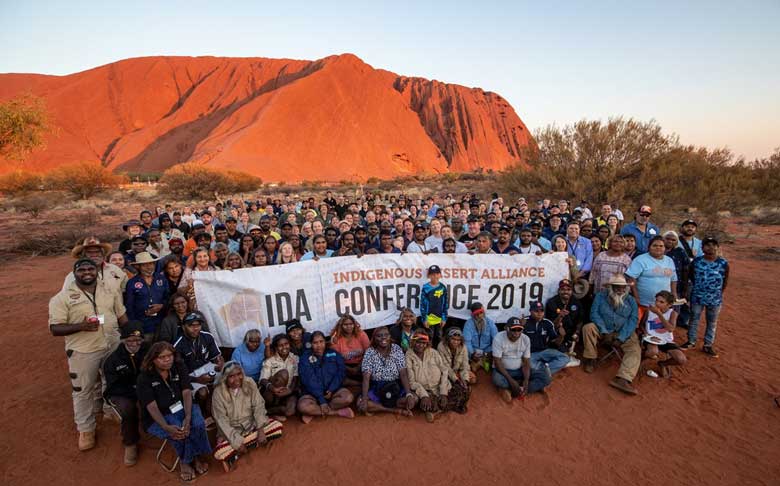
Indigenous Ranger Forum
In August 2019, over 400 people from 60 different Indigenous ranger groups travelled thousands of kilometres to attend the Indigenous Ranger Forum. The three-day gathering was hosted by the Kenbi Rangers on the Cox Peninsular. Workshops included aquatic biosecurity, microplastics sampling, sea turtle and crocodile management, biocontrol of weeds and insects, and drone use. NT, 2019.
Working with conservation partners
Since 2016, the Waanyi Garawa and Garawa Rangers have collaborated with Bush Heritage Australia to hold annual wildlife surveys and Culture camps.
Local women are employed as rangers to help with the wildlife surveys and Culture camps which are held during the school holidays so children can attend.
In September 2020, teachers from 2 local schools were also involved, with senior students from the Borroloola School attending as part of their Learning on Country Program. The school kids helped set up survey sites, search for animals and check traps. They also participated in cultural activities guided by Elders, which included painting, dancing, weaving, and making bush medicine. NT, 2017–21.
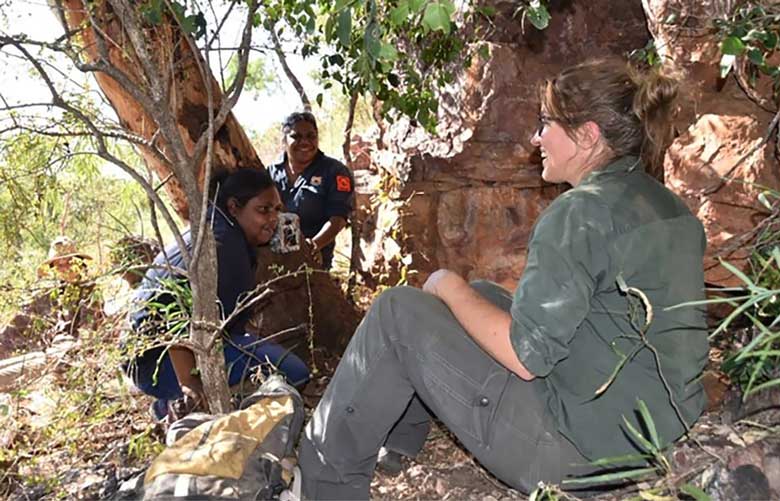
Sharing fire knowledge in Africa
A delegation of Indigenous Rangers and leading fire scientists from Northern Australia flew to Botswana to attend the International Savanna Fire Management Initiative in May 2019. Over 10 days, traditional fire management practices and knowledge of fire were shared with the people of Botswana.
The delegation explained how Indigenous communities are combining their traditional knowledge with modern science and technology to burn early and keep fuel loads down.
There are 25 Indigenous-led carbon projects in Northern Australia. They have resulted in less destructive wildfires and decreased greenhouse gas emissions while creating more than 400 seasonal jobs in remote communities. NT, WA, 2019.
Fee-for-service activities
Project fee-for-service activities are services undertaken in exchange for payment and that use grant-funded resources (e.g. rangers being paid with grant funds, assets paid for with the grant). Fee-for-service activities may enable ranger groups to grow their organisation, fund additional positions and/or build ranger capability by accessing further training and a more extensive variety of work experiences. These activities can offer diversification and stability for ranger groups by broadening the group’s investment base, increasing employment opportunities and fostering partnerships.
Building fee-for-service capability
Gidarjil Rangers have undertaken a range of training and development. This has enabled them to identify and take advantage of emerging fee-for-service opportunities, for example using underwater drones to inspect infrastructure such as moorings and vessel hulls.
Having qualified and capable rangers has also allowed the group to build on their current fee-for-service contracts, including an extension of their inshore coral and water quality monitoring project and collaborating with the local council and Queensland Parks and Wildlife Service around the use of traditional burns to manage weeds. Qld, 2019–20.
Undertaking river and sea patrols
The Numbulwar Numburindi Rangers have a contract with NT Fisheries to do regular patrols along the South East Arnhem Land IPA coast and Roper River. Their work includes monitoring fishing compliance, recording suspicious activity and educating visitors about fishing regulations.
The rangers carried out 16 patrols, recovering a variety of fishing apparatus including nets, traps, floats and lines as well as identifying fishing activity in and around Edward Island to the south of Numbulwar. NT, 2018–19.
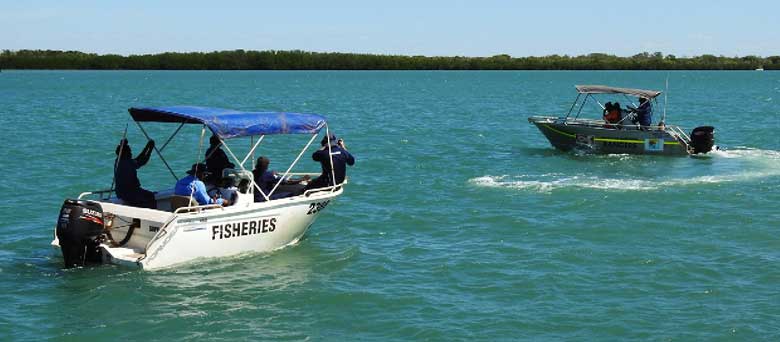
Sandalwood contract
The Goldfields Land and Sea Rangers were awarded a contract by the Forest Products Commission for sandalwood harvesting and regeneration. The rangers harvest sandalwood timber, and collect and sow seeds to regenerate trees. The timber is processed locally to make sandalwood oil. WA, 2017–18.
Fire abatement work
The Mimal Rangers’ burning work for the Arnhem Land Fire Abatement Project funds ranger jobs and helps keeps Country healthy. The rangers work collaboratively with Arafura Swamp, Djelk, Jawoyn, Yugul Mangi, Numbulwar, Yirralka, and Warddeken Rangers on the project.
The rangers burn early and create fire breaks that reduce large and damaging wildfires with associated greenhouse gases. In 2019, the Mimal Rangers also assisted neighbouring ranger groups and pastoralists with late season firefighting. NT, 2019–20.
_200.jpg)
Fire abatement challenges
The Dambimangari Rangers secured fee-for-service income from prescribed early burning undertaken as part of the North Kimberley Fire Abatement Project. However, due to 2019–20 wildfires, over 50,000 hectares of Dambimangari Country was burnt, which dramatically reduced the Australian Carbon Credit Units and associated income normally achieved. WA, 2019–20.
Fruit fly control in the Torres Strait
During the summer months, exotic fruit flies are blown into the Torres Strait from Papua New Guinea. If not stopped, the fruit flies attack locally grown fruit and vegetables and could also affect Queensland’s horticultural industries.
Erubam, Iamalgal and Boigu Rangers have completed fruit fly ‘blocking’ as a fee-for-service activity on Torres Strait Islands for Biosecurity Queensland. Blocks are nailed to trees, which then attract and kill male fruit flies – stopping the breeding cycle. Other Torres Strait ranger groups monitor, empty and change lures in fruit fly traps as a fee-for-service activity for the Department of Agriculture, Water and the Environment (DAWE). Qld, 2019–20.
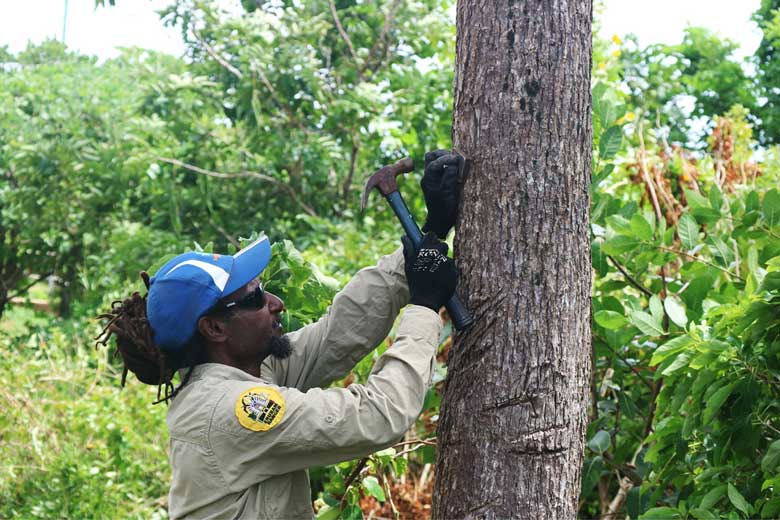
Aerial culling of feral animals
In 2018–19, a Gangalidda Garawa ranger undertook training to become an aerial culler as part of the Carpentaria Land Council Aboriginal Corporation’s (CLCAC) Aerial Feral Animal Project. The training included learning how to use fire arms from an aircraft to humanely remove introduced animals.
In November 2018, a second Gangalidda Garawa ranger delivered the first fee-for-service aerial cull under contract to a large local pastoralist group. The feedback was positive, opening up another fee-for-service opportunity for Gangalidda Garawa Rangers and the CLCAC. Qld, 2018–19.
Developing commercial activities
Removing and managing camels
During 2018–19, the Ngaanyatjarra IPA was experiencing a period of extreme drought and camels looking for water were starting to cause damage around communities. The Ngaanyatjarra Rangers, working alongside the Ngaanyatjarra Camel Company, removed and sold 6,580 feral camels from the IPA during the financial year. This helped reduce camel damage and has created income to fund jobs. WA, 2018–19.
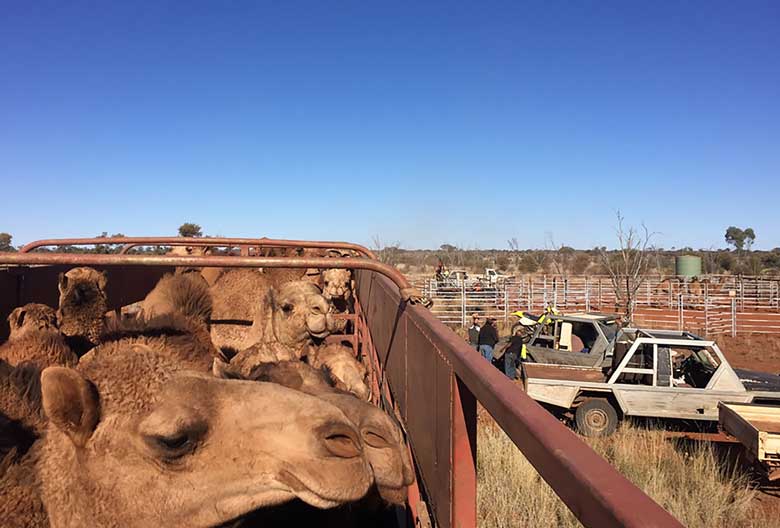
Oyster farming trial
Tiwi Rangers worked with NT Fisheries and Traditional Owners to trial commercial oyster production.
Oysters have been trialled on the Tiwi Islands before with limited success. This new trial uses baskets suspended between star pickets so the oysters are underwater at high tide and out of the water at low tide. This exposes them to more natural conditions and should help them grow rapidly.
Rangers continued to clean the oyster baskets each month and 2 rangers attended the Tropical Rock Oyster Launch in Darwin in November 2019.
Security became an issue after some of the oyster baskets were removed. The rangers plan to liaise with NT Fisheries about re-establishing the site and assessing other potential sites. NT, 2019–20.
Uunguu visitor pass and training
National Parks have been using entrance and camping fees or visitor passes as a way of raising revenue for many years. The Uunguu Visitor Pass was introduced to the Uunguu IPA by the Wunambal Gaambera Aboriginal Corporation in 2017. The rollout of the visitor pass has been well received and, by the end of 2018, it was purchased by over 90 per cent of tour operators and 80 per cent of independent travellers.
The money raised has been invested into jobs, training and infrastructure to benefit local Indigenous people as well as tourists.
In 2018, 11 Uunguu Rangers and Traditional Owners undertook tourism training to develop their tour guide skills. They have also been learning the stories, songs and dances from their Elders to share with visitors. In 2019, the trainees completed 31 tours and performed junba (dance) for visitors to Ngula-Jar Island.
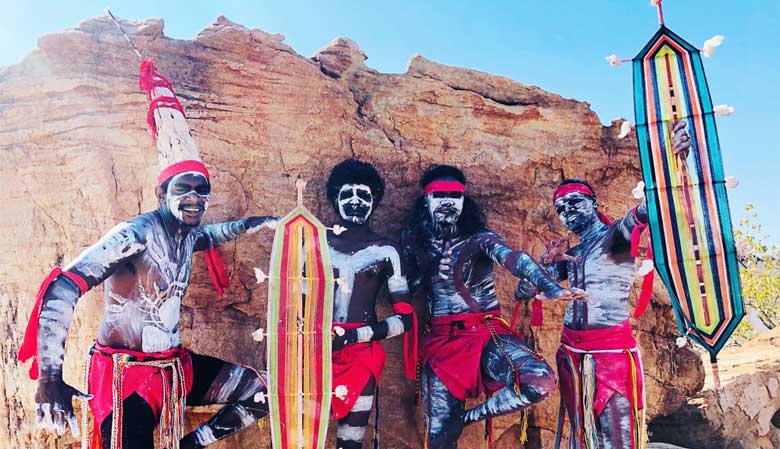
Rangers and guides manage Munurru campground, the gateway to the Mitchell Plateau (Ngauwudu), by working fortnightly rosters. They hosted over 5,000 campers at the 100 site, 4WD campground over the 2018 dry season. WA, 2018–20.
Meeting the Traditional Owners of this Country, who manage the campground, has been a highlight.
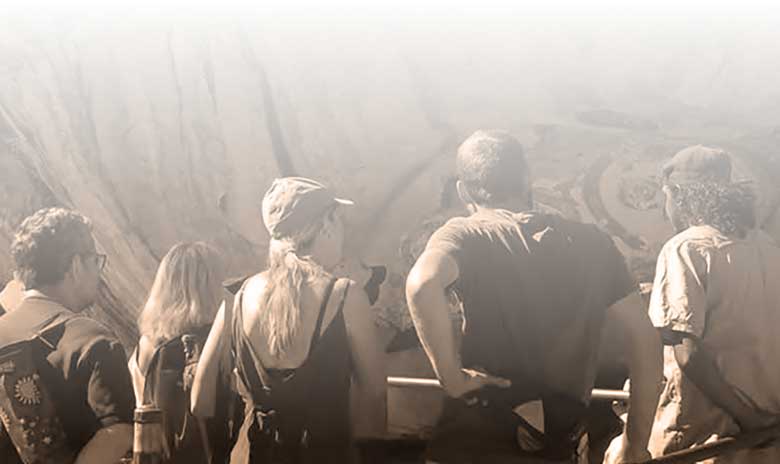
Conclusion
These stories have provided insight into the important work undertaken through First Nations land and water management projects across the country.
The future is bright for Indigenous Rangers and Indigenous Protected Areas.
The Murray-Darling Basin Indigenous River Rangers Program was announced in July 2021 to support waterway health. This $3.1 million dollar program established 5 new ranger groups across the Basin. At publication in 2022, this program has recently been extended by $9.5 million dollars to operate into 2025.
The importance of caring for sea Country was recognised with the announcement of successful grant recipients under the new Sea Country IPA Program Grant Opportunity in May 2022. This funding opportunity provides an additional $9.7 million in grants to establish 10 new sea Country IPAs or to extend current terrestrial IPAs into sea Country to June 2023.
More recently, the Government has committed to doubling the number of Indigenous rangers by the end of the decade, and to increasing funding to Indigenous Protected Areas by $10 million per year.
The new funding will establish new ranger groups, add more rangers to existing groups and establish new ranger initiatives around Australia, allowing rangers to deliver self-determined project outcomes that align with Traditional Owners’ objectives for Country. This will continue to increase the application of Traditional knowledge and cultural practices, providing long-term economic opportunities, environmental outcomes and protecting First Nations cultural heritage.
Thank you to all Indigenous Protected Area and Indigenous Ranger Program teams around Australia for your stories and photographs and for your continued work to care for Country.






